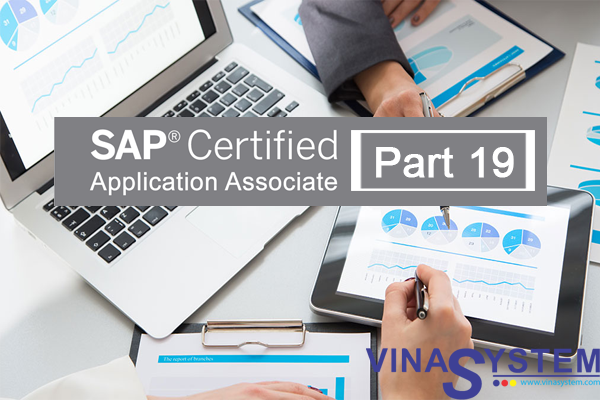
Accounting for Sales and Purchasing in SAP Business One
Welcome to the Accounting for Sales and Purchasing topic in SAP Business One. In this topic, we will cover some general accounting conventions and give examples of the automatic journal entries that are created during the sales, purchasing, and inventory processes. We will also talk about some financial settings that affect these automatic journal entries.
I/ Business Scenario
Imagine that you are implementing SAP Business One at a new customer OEC Computers. Your main contact is the OEC Computers accountant, Maria.
Maria is very interested in the implementation and asks you about how SAP Business One handles the financial accounting process.
She wants to make sure she understands the big picture so she can report business results to the company owners each period.
II/ Agenda
Let us discuss some financial basics.
1/ Finance Basics

Every business transaction is recorded in the company's books.
This allows you:
- To manage your company effectively with the option of producing financial reports
- To report the business transactions to the authorities.
Every business transaction results in a value exchange:
- A certain account increases value and another decreases value, resulting in the recording of balancing debit side and credit side postings.
a) Automatic Journal Entries:
i) Reflection Question

In other topics we learned about the documents in the sales process and their consequences on bookkeeping.
To review this process let us try to answer the following question:
In a standard sales process which documents affect the accounting system?
ii) Answer

These are the documents in the sales process that create automatic journal entries and therefore affect the accounting system: the delivery, the A/R invoice, the incoming payment and the deposit. Note that the delivery only creates an accounting posting if you are using perpetual inventory.
b) A/R Invoice Journal Entry

In SAP Business One, a journal entry is automatically posted for many documents during the sales, purchasing and inventory processes.
Now let us assume for a moment that we are in a non-perpetual inventory system in order to keep our example simple. In that case, in our sales process example, the A/R Invoice automatically creates the following journal entry:
- There is a debit to the customer account for the total price of the sale.
- There is a credit to the tax account for sales tax and a credit to the revenue account for the sales price (excluding tax).
Starting at version 9.2 you have the option to split the journal entry posting by document lines. That is, rows with the same G/L accounts are not grouped in the created journal entry. One row in a journal entry is linked to one row in the marketing document.
To enable this option, in the Document Settings window, under the General tab, choose the Split option in the Split Journal Entry Posting by Document Lines field.
Let us focus on the debit side. Each transaction registered for the customer affects the customer account balance. Now let us look at the customer account in more detail.
c) The Account Balance

This is an example of the customer account.
The account balance represents the difference between the total debit transactions and the total credit transactions recorded for that account.
The transaction summary or the balance of a certain G/L account or business partner is the initial information the accounting system can provide about the business.
In the graphic, we see that the total debits are greater than the total credits, so the account has a debit balance.
Previously, we mentioned that in each journal entry a certain account increases value and another decreases value, resulting in the recording of balancing debit side and credit side postings.
The effect on the account balance would be:
- Assets, Expenses, and Drawings accounts are generally in debit.
- Liability, Revenue, and Capital (Equity) accounts are generally in credit.
d) Account Types

Here, we see the typical account balance of the different account types.
For example, let us look at the value exchange for assets and liabilities.
For assets:
- Debit transactions always increase the asset value.
- Credit transactions always decrease the asset value.
For liabilities:
- Credit transactions always increase the liability.
- Debit transactions always decrease the liability.
We will discuss the different account types in another course.
e) Value Exchange:
i) Reflection Question

In a typical A/R invoice, what is the effect of the debit and credit amounts on the involved account balances?
Once again we will make some assumptions to keep the example simple: Let us assume that the customer is tax exempt and that this is a non-perpetual inventory system.
ii) Answer

The answer is that the two accounts increase their values.
The customer account is considered an asset so any debit to this account increases the account’s value.
A credit to the revenue account, as we saw on the previous slide, increases the account’s value.
Note that you can preview the corresponding journal entry posting and the involved accounts before you add a document that generates journal entry. You can do so by choosing the Journal Entry Preview icon from the toolbar or by right click the document and choosing the Journal Entry Preview option.
2/ Financial Settings: Which Accounts to Use Automatically?

In the journal entries that are automatically posted by documents in SAP Business One, how does the system “know” which accounts to use?
The system knows which accounts to use because when you initialize SAP Business One, you define default G/L accounts related to a specific business processes in the G/L Account Determination window.
In this window, you also define control accounts that link the business partner sub-ledger accounts to the general ledger.
a) G/L Account Determination
For Items Used in Documents

First let us review how accounts are determined for items used in business processes.
As we mentioned, when you first implement SAP Business One you define default G/L accounts to be used when transactions are created during the different business processes, such as sales, purchasing and inventory.
These default accounts are defined in the setup menu under the Administration module. Under Setup you will find a section for Financials which includes the transaction for G/L Account Determination.
When items are used in the transactions, there are 2 options for account determination:
- In the traditional solution the system looks for the default accounts based on the account determination set in the item master data.
- Starting at version 9.0, you can work with the advanced solution for account determination.
- The advanced solution provides a centralized matrix to determine rules for assigning G/L accounts in journal entries according to a predefined (closed) list of criteria.
- Both options are based on the G/L Account Determination window.
- We will discuss these options in the Default G/L accounts unit.
b) Control Accounts
The Link Between the BP Sub-Ledger and the General Ledger

In the G/L Account Determination window you also define the Control Accounts: Accounts Receivable for the Sales process and Accounts Payable for the Purchasing process.
A control account links the business partner sub-ledger accounts to the general ledger.
You need to define a G/L account as a Control Account in the Chart of Accounts.
Whenever you post a document to a business partner, the system automatically registers the journal entry to:
- The Business Partner Master Data account balance, and
- The control account balance.
- You cannot post journal entries directly to a control account.
In an A/R Invoice, for example, when the customer is debited the Accounts Receivable account is also debited.
This journal entry appears now in both accounts balances (the customer and the control account).
c) Chart of Accounts

Note, that the Business Partner Master Data balances do not appear in the Chart of Accounts. Only the receivable and payable control accounts appear.
The receivable and payable control accounts accumulate the customers’ and vendors’ transactions in their balances.
Therefore, the Chart of Accounts presents the complete financial status of the company.
he Financial Reports also show the full picture. For example, the balance sheet contains the accounts receivable and accounts payable accounts.
d) Automatic Journal Entry Value

We have learned how the system “knows” which accounts to use in automatic journal entries.
This is done using the values defined in the G/L Account Determination window.
But, how does the system “know” the value to be credited and debited in those automatic journal entries? For example, in an automatic journal entry created by an A/R Invoice?
e) Value Calculation
i) Sales

Here is a common scenario of how prices are set in SAP Business One during the sales process:
Note! In the following slides we assume that no special prices or discounts were defined for the involved items and business partners.
Our customer Star Trek Computers asks for an offer on 4 portable media players.
Jean creates a sales quotation. She chooses the customer and then the item. The price per unit appears in the quotation. How?
- The Item master data includes 3 optional prices for this item. Each one of them is represented in a different price list.
- Star Trek Computers is a reseller customer and so his default price list as defined in his master data record is the Reseller Price List.
- Therefore, in the Sales Quotation, the unit price for a portable media player is 110, the price from the Resellers Price List.
The sales person Jean enters quantity of 4.The total value of the quotation is 440 (assuming there are no additional items in the quotation and that no discount, freight charges or tax amounts are added).
Star Trek Computers mails us a Sales Order based on the Sales Quotation.
In SAP Business One, Jean copies the Sales Quotation to a Sales Order.
2 days later Joe, the warehouse manager, dispatches the company truck with the weekly deliveries, including 4 portable media players for Star Trek Computers.
Later on the day, the accountant copies the Delivery to an A/R Invoice.
Since no change was done to the price during the Copy To process, the Invoice’s total value is 440, and these are the Credit and Debit amounts in the automatic journal entry created by the A/R Invoice.
ii) Purchasing

In the Purchasing process a common scenario of how prices are set would be:
Joe, the warehouse manager, issues a purchase order of 10 portable media players. He chooses the vendor Coconut Devices and then the item - portable media player. The price per unit appears in the Purchase Order. How?
- Since Coconut Devices is a vendor, his default price list as defined in his master data record is the Purchasing Price List.
- Therefore, in the Purchase Order, the unit price for portable media player is 100, the price from the Purchasing Price List for the portable media player item master data.
Joe enters a quantity of 10. The total value of the Purchase Order is 1000 (assuming there are no additional items in the Purchase Order and that no discount, freight charges or tax amounts are added).
Joe e-mails the Purchase Order to the vendor.
Few days later Joe receives a delivery including 10 portable media players from Coconut Devices.
In SAP Business One, he copies the Purchase Order to a Goods Receipt PO.
A week later, the Invoice from Coconut Devices arrives via mail and the accountant copies the Goods Receipt PO to an A/P Invoice.
Since no change was made to the price during the Copy To process, the A/P Invoice total value is 1000, and these are the Credit and Debit amounts in the automatic journal entry created by the A/P Invoice.
iii) Inventory

Let us go one step back, to the Goods Receipt PO that Joe entered based on the Delivery he got from the vendor.
Assuming the company runs perpetual inventory, an item cost value is being calculated automatically in each stock transaction.
More details on perpetual inventory are provided in a separate course.
When Joe entered the Goods Receipt PO to SAP Business One, the Purchasing Price List value (100 per unit) affected the unit price in the Goods Receipt PO and also the item cost value.
The item cost value is calculated automatically, behind the scenes, according to the valuation method chosen for the item (Moving Average, FIFO, or Standard). This particular item was set up as moving average, so based on the total number of items in stock and the purchase prices previously paid, the calculated item cost value after the Goods Receipt PO was 90.
Joe entered a quantity of 10 portable media players. Therefore, the total value of the journal entry created by the Goods Receipt PO was 1000 and these are the Credit and Debit amounts registered to the inventory default accounts.
However, the value of the journal entry linked to the Delivery sent to the customer is 360. That is, the quantity of 4 items multiplied by the item cost value at that moment (90).
Remember that the total value of the Invoice based on that Delivery was 440. It was calculated according to the Reseller Price List (110) that is defined as the default price list in the customer master data record.
III/ Summary
Here are some key points to take away:

- The account balance represents the difference between the total debit transactions and the total credit transactions recorded for that account.
- In each journal entry a certain account increases value and another decreases value and the debit side and the credit side balance.
- Assets, Expenses, and Drawings accounts are generally in debit.
- Liability, Revenue, and Capital (Equity) accounts are generally in credit.

- In automatic journal entries the system ‘knows’ which accounts to use because you defined default G/L accounts in the G/L Account Determination window. These default accounts include control accounts that link the business partner sub-ledger accounts to the general ledger.
- The Business Partner Master Data balances are represented in the chart of accounts in the receivable and payable control accounts that accumulate the customer and vendor transactions in their balances.
- In an A/R Invoice the system ‘knows’ the value to be credited and debited in the automatic journal entry using the default price list as defined in the customer master record and the item price in this price list.
- In a Delivery the system ‘knows’ the value to be credited and debited in the automatic journal entry using the item cost value that is calculated automatically, behind the scenes, according to the valuation method chosen for the item.






